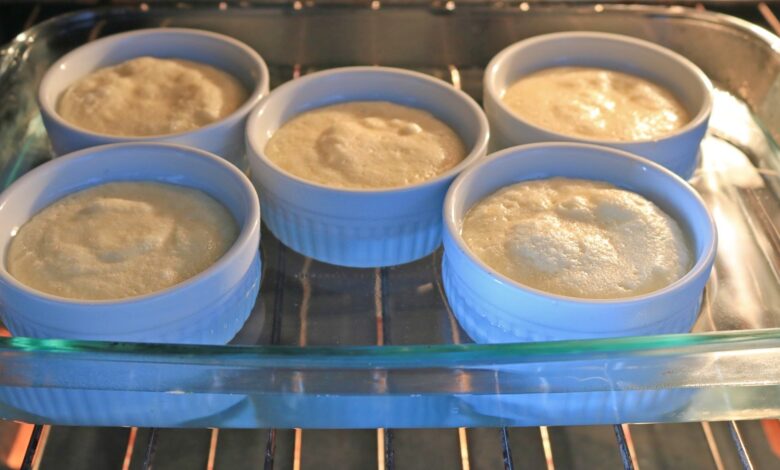You Should Make This Lemon Pudding Cake All Summer Long

The much-Instagramed spoonful of fluffy lemon cake with some pudding underneath may have made its way across your feed on more than one occasion, which makes it all the more easy to scroll by and forget in an instant. What’s so special about eating pudding and cake?, you may be thinking. I’d encourage you to take a second look: It’s actually one batter that bakes into two distinct layers, and frankly, it’s the light, bright, and sumptuous dessert you should be enjoying all summer.
How does lemon pudding cake become two layers?
I once was in the early stages of testing a recipe and made a cake with whipped egg whites as the leavening agent and binder. The batter was a little weird and thin, but I baked it off anyway. I knocked the cake out and was disappointed. The top was gorgeous, perfectly browned, and bouncy. But lurking an inch under the surface was a dense mess. I hadn’t added enough egg white to lighten and lift the batter, so the aerated portion floated above the rest. That cake was a failure. Lemon pudding cake, however, harnesses that mistake as a technique.
Lemon pudding cake batter is watery, with a seemingly scant portion of flour used for a cake. Then you gently fold in whipped egg whites before pouring it into the cake pan. What you’ll surely notice is that even though the egg whites are thoroughly folded in, they’re floating above the rest of a deeply marigold, runny batter. That batter happens to be the lemon juice, sugar, butter, egg yolks, and a wee bit of flour. My fellow bakers, those are the building blocks of a lemon curd.

Credit: Allie Chanthorn Reinmann
The egg white-leavened lemon curd bakes into a light cake above, and the batter that sinks cooks into the soft, tangy, pudding-like curd you know and love. The only bit of fuss you have to manage is setting up a water bath so the curd can gently set. It’s worth the trouble.

Credit: Allie Chanthorn Reinmann
I wanted a recipe with individual servings, so this recipe will make enough for five six-ounce ramekins. If you’re not interested in small servings, this recipe can be made in a single cake pan or small casserole dish, as long as you have a larger dish to accommodate it (for the water bath). The cake is pleasantly lemony, not too tart, and needs no dressing up—the lemon curd underneath scratches that itch for icing. It’s absolutely delightful enjoyed warm, or as a cool snack straight out of the fridge.
Mini Lemon Pudding Cakes Recipe
Ingredients:
1. Preheat the oven to 350°F. Set up five six-ounce ramekins in a 13 by 9-inch casserole dish. Butter the ramekins and leave them in the dish. Meanwhile, heat up a kettle of water to boil.
2. In a large mixing bowl, whisk the egg yolks, lemon juice, lemon zest, and butter. In a different bowl, mix together the flour, sugar and salt. Have the milk on standby.
3. Slowly whisk in half of the sugar mixture, then half of the milk. Whisk in the rest of the sugar mixture, followed by the rest of the milk.
4. Whip the egg whites in, yet again, a different bowl until you get soft peaks. Try to keep them soft; if they get too whipped, they can be hard to incorporate into this liquid-y batter. Gently fold the egg whites into the batter. I did it in four additions.
5. Using a small ladle or a large disher, divide the batter amongst the ramekins. Don’t just scoop from the top. Make sure to start down at the bottom of the bowl in order to get both parts of the batter.
6. Put the large dish with the ramekins into the oven and then pour the just-boiled water into the outer dish. The water should come halfway up the sides of the ramekins. Bake the cakes for 20 to 25 minutes, or until the tops are set, browning, and just starting to pull away from the edges.
Carefully remove the ramekins from the bath and cool on a wire rack for at least 15 minutes before serving.

